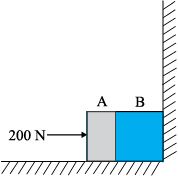(a) Mass of body A, = 5 kg
Mass of body B, = 10 kg
Applied force, F = 200 N
Coefficient of friction, = 0.15
The force of friction is given by the relation:
= 0.15 (5 + 10) × 10
= 1.5 × 15 = 22.5 N leftward
Net force acting on the partition = 200 – 22.5 = 177.5 N rightward
As per Newton’s third law of motion, the reaction force of the partition will be in the
direction opposite to the net applied force.
Hence, the reaction of the partition will be 177.5 N, in the leftward direction.
(b) Force of friction on mass A:
= 0.15 × 5 × 10 = 7.5 N leftward
Net force exerted by mass A on mass B = 200 – 7.5 = 192.5 N rightward
As per Newton’s third law of motion, an equal amount of reaction force will be exerted
by mass B on mass A, i.e., 192.5 N acting leftward.
When the wall is removed, the two bodies will move in the direction of the applied force.
The net force acting on the moving system = 177.5 N
The equation of motion for the system of acceleration a, can be written as:
Net force causing mass A to move:
= 5 × 11.83 = 59.15 N
Net force exerted by mass A on mass B = 192.5 – 59.15 = 133.35 N
This force will act in the direction of motion. As per Newton’s third law of motion, an equal amount of force will be exerted by mass B on mass A, i.e., 133.3 N, acting opposite to the direction of motion.

